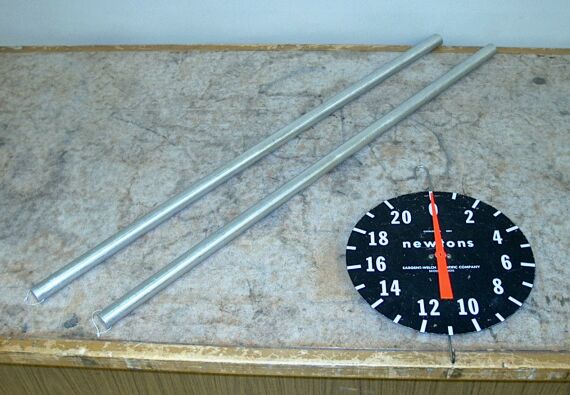

Weigh each of these rods with the spring scale to show that they weigh the same (11.1 N; they are 91.7 cm long). Have one volunteer grasp one rod in the middle and another volunteer the other rod likewise. See who can waggle his rod faster. For one volunteer, the task will be easy. The other will have some difficulty rotating the rod. This is because plugs set at different places within the two rods give them greatly different moments of inertia. A way to introduce some humor into the demonstration is to give the rod with the lower moment of inertia to a petite person, and the one with the greater moment of inertia to a large, obviously muscular person. The smaller person will have no trouble moving the rod quite quickly, while the large, muscular person will have quite a struggle to try to keep up.
As noted in demonstration 28.24 – Angular acceleration, the moment of inertia, I, of an object is the sum of the products of its mass points and the squares of their distances from the particular axis about which the object is being rotated, i.e., I = Σmiri2. For a rod having uniform mass distribution and length l being rotated about a perpendicular axis through the center, as in this demonstration, I = Ml2/12. The key to this demonstration, though, is that the mass distribution in these rods is far from uniform. One rod has most of its mass concentrated near the center, and thus has a low moment of inertia. The other rod has its mass concentrated near the ends, which gives it a very large moment of inertia. The ideal, limiting cases for these would be one rod with the mass right at the center, which would give it a moment of inertia of zero, and the other rod with half the mass at each end, to give it a moment of inertia, I = M(l/2)2. (The moment of inertia for each end would be I = (M/2)(l/2)2, and the two would add up to I = M(l/2)2.) In either case, we would be ignoring the moment of inertia of the outer case of the rod, whose mass is presumably much smaller than that of the plugs inside, and so does not add much to the overall moment of inertia. It is impossible, of course, to make such rods as described above for the ideal cases, but we can place enough of the mass of the rod close enough to either the center or the ends to make one rod with a very small moment of inertia, and one whose moment comes fairly close to that of a rod with its mass concentrated at both ends.